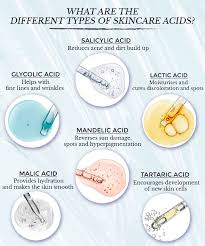
How to layer hyaluronic acid and lactic acid
“How can I use more than one acid?” is a question we often receive in our inboxes. Understanding how to layer skincare ingredients can be tricky at the best of times, but when you consider using acids together, things get even more complicated. Using the wrong acids together can lead to skin irritation and prevent both products from achieving their best results. However, finding a winning combination will give you the best skin possible.
Today we focus on two well-known and commonly used acids, hyaluronic acid and lactic acid. What they do for the skin and how to layer them when using them in your skincare routine.
Are hyaluronic acid and lactic acid the same?
No, they are not, but lactic acid is one of the gentlest AHAs and not only exfoliates, it also acts as a humectant. Praised for its hydrating properties, hyaluronic acid helps lock in moisture in the skin, leaving the surface layer and protective barrier fully hydrated and fortified, helping to protect against free radical damage from pollution, UV rays, central heating and other environmental aggressors.
The main difference between the two acids is that, unlike lactic acid, hyaluronic acid does not have exfoliating properties. Lactic acid removes the buildup of dead skin cells that can lead to breakouts, flaking, and dull complexion. Conversely, hyaluronic acid nourishes the outer and lower layers of the skin, plumping them up, moisturizing, and visibly improving the appearance of the skin.
Can hyaluronic acid and lactic acid be used together?
While both products have “acid” in their name, they actually work completely differently on the skin:
Lactic acid
As part of the alpha hydroxy acid (AHA), lactic acid provides a chemical peel, or h. It removes the buildup of dead skin cells and clears impurities and bacteria from the skin. The beauty of lactic acid is that it is derived from fructose and sour milk, and is known as one of the gentlest AHAs because its molecular size is so large that it can’t penetrate too deeply into the underlying layers, causing skin reactions and irritation. You’ll also find that lactic acid has unique properties as a humectant, or h. It locks in moisture in the skin, keeping it healthy, plump, and youthful.
Hyaluronic acid
This skin hero is everyone’s favorite. Its ability to bind twice its weight in water makes it one of the most hydrating ingredients used in a variety of effective moisturizing products. This powerful humectant draws moisture into the skin, keeping the surface barrier and even the underlying layers of the skin hydrated all day long. This not only keeps the skin healthy, but also prevents possible skin irritation.
Now that you have a better understanding of the differences between these acids, it will be easier to figure out how they work together. Because of the hydration provided by hyaluronic acid, there is no need to worry if irritation occurs due to lactic acid (although it is rare).
When using these ingredients together, it is important to consider the formulations, as they will determine how lactic acid and hyaluronic acid are used together. For example, I have found the most effective formulations containing lactic acid to be an exfoliating toner and cleanser. Then apply a serum containing hyaluronic acid. Here is how to prepare your skin so that it is at its healthiest and looks its best. If this sounds confusing, the next section is for you, as I will now go into more detail about the order in which lactic acid should be used.
In what order do you use lactic acid?
As I mentioned earlier, when using skin care ingredients, you need to pay attention to the consistency of the formula. The general skin rule is that skincare products should be applied in order from thinnest to thickest layers. Typically, hyaluronic acid is used in products that are left on the skin for the majority of the day. This is because HA’s moisturizing properties work tirelessly and continuously once applied to the skin.
You’ll also find lactic acid in a variety of products, from cleansers to toners to serums. By applying lactic acid before hyaluronic acid, you can give your skin the benefits of gentle exfoliation before restoring moisture after using a serum rich in hyaluronic acid. However, if you also opt for a lactic acid serum, allow 10 minutes between applications to ensure that each active ingredient in the formula reaches the areas needed to achieve your skin goals.
What Not to Mix with Hyaluronic Acid?
Believe it or not, given all the diverse ingredients in skincare, hyaluronic acid works for just about everyone! However, due to its moisturizing properties and ability to keep the skin’s natural protective barrier fully functioning, it’s important to consider which products and ingredients you combine with hyaluronic acid to ensure they’re the right fit for you and your skin.
This can be easily achieved by performing a 24-hour patch test on new ingredients or products to avoid unwanted skin reactions and irritation. If you have any further concerns, it’s best to consult a doctor or dermatologist.
Can Hyaluronic Acid be Used with Niacinamide and Lactic Acid?
If you already use hyaluronic acid and lactic acid, introducing niacinamide into your routine isn’t as complicated as it may seem. Although niacinamide has similar benefits to hyaluronic acid, it has some unique properties that are helpful when used in conjunction with the rest of your skin care routine. Both niacinamide and hyaluronic acid act as humectants, helping the skin to remain plump. The main difference between them is that hyaluronic acid binds more water to the skin, while niacinamide regulates sebum production, restoring balance to the skin’s surface and ensuring that any products you subsequently use work more effectively.
Can I apply a moisturizer after using lactic acid?
Absolutely, it’s a good idea, especially if you have a dry or sensitive skin type that may be irritated when using AHAs or other chemical exfoliants (even ones as gentle as lactic acid).Applying a moisturizer after using products containing lactic acid soothes the skin and creates a physical barrier in the outer layer, ensuring that the skin is protected from free radicals. These free radicals, like other factors such as pollution, UV rays and central heating, can also cause damage to the skin, leading to dark spots, pigmentation, fine lines and wrinkles.
Here you have more information on how to use both lactic acid and hyaluronic acid in your skin care routine. Don’t forget to check out our previous blog post where we explain how to use effective skin care ingredients together.
If you have any questions or just want to say hello, visit us on Instagram!


